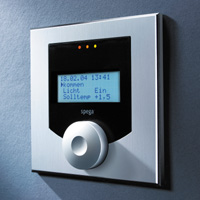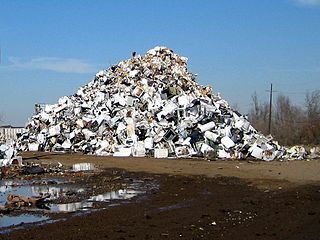
X10 is a protocol for communication among electronic devices used for home automation (domotics). It primarily uses power line wiring for signaling and control, where the signals involve brief radio frequency bursts representing digital information. A wireless radio based protocol transport is also defined.

In electronics, a remote control is a component of an electronic device used to operate the device from a distance, usually wirelessly. For example, in consumer electronics, a remote control can be used to operate devices such as a television set, DVD player, or other home appliance, from a short distance. A remote control is primarily a convenience feature for the user, and can allow operation of devices that are out of convenient reach for direct operation of controls. In some cases, remote controls allow a person to operate a device that they otherwise would not be able to reach, as when a garage door opener is triggered from outside or when a Digital Light Processing projector that is mounted on a high ceiling is controlled by a person from the floor level.
A major appliance, or domestic appliance, is a large machine in home appliance used for routine housekeeping tasks such as cooking, washing laundry, or food preservation. An appliance is different from a plumbing fixture because it uses electricity or fuel.
Universal Plug and Play (UPnP) is a set of networking protocols that permits networked devices, such as personal computers, printers, Internet gateways, Wi-Fi access points and mobile devices to seamlessly discover each other's presence on the network and establish functional network services for data sharing, communications, and entertainment. UPnP is intended primarily for residential networks without enterprise-class devices.

Home automation or domotics is building automation for a home, called a smart home or smart house. A home automation system will control lighting, climate, entertainment systems, and appliances. It may also include home security such as access control and alarm systems. When connected with the Internet, home devices are an important constituent of the Internet of Things.

Home appliances, also known as domestic appliances, are electrical machines which helps in household functions, such as cooking, cleaning or food preservation.
LonWorks is a networking platform specifically created to address the needs of control applications. The platform is built on a protocol created by Echelon Corporation for networking devices over media such as twisted pair, powerlines, fiber optics, and RF. It is used for the automation of various functions within buildings such as lighting and HVAC; see building automation.
A smart device is an electronic device, generally connected to other devices or networks via different wireless protocols such as Bluetooth, NFC, Wi-Fi, LiFi, 3G, etc., that can operate to some extent interactively and autonomously. Several notable types of smart devices are smartphones, smart cars, smart thermostats, smart doorbells, smart locks, smart refrigerators, phablets and tablets, smartwatches, smart bands, smart key chains, smart speakers and others. The term can also refer to a device that exhibits some properties of ubiquitous computing, including—although not necessarily—artificial intelligence.
A remote, online, or managed backup service, sometimes marketed as cloud backup or backup-as-a-service, is a service that provides users with a system for the backup, storage, and recovery of computer files. Online backup providers are companies that provide this type of service to end users. Such backup services are considered a form of cloud computing.
A media server refers either to a dedicated computer appliance or to a specialized application software, ranging from an enterprise class machine providing video on demand, to, more commonly, a small personal computer or NAS for the home, dedicated for storing various digital media. This can also mean that these servers are specialized for media for streaming

Devon and Somerset Fire and Rescue Service is the statutory fire and rescue service covering the county of Devon and the non-metropolitan county of Somerset in South West England. The service does not cover the unitary authorities of North Somerset and Bath and North East Somerset, which are covered by the Avon Fire and Rescue Service. It is the fifth largest fire and rescue service in the United Kingdom.
In computing, the term remote desktop refers to a software or operating system feature that allows a personal computer's desktop environment to be run remotely on one system, while being displayed on a separate client device. Remote desktop applications have varying features. Some allow attaching to an existing user's session and "remote controlling", either displaying the remote control session or blanking the screen. Taking over a desktop remotely is a form of remote administration.
Holtek Semiconductor is a Taiwan-based semiconductor design centre and provider. Along with its headquarters and design operations based in the Hsinchu Science Park in Taiwan, Holtek operates worldwide with a wide range of global agents. Holtek's design focus is in both 32-bit and 8-bit along with Touch microcontroller development with the company having around 650 employees. Holtek also designs and provides peripheral semiconductor products such as remote control, telecommunication, power management, computer peripheral, and memory devices. Holtek's device application area is concentrated in the consumer product field such as household appliances, computer peripheral products, remote controllers, leisure products, medical equipment as well as industrial controllers. Holtek microcontrollers are in home appliances including brands such as Philips, Siemens, Märklin and Japanese brands such as Futaba and Sony.

Staffordshire Fire and Rescue Service is the statutory fire and rescue service responsible for fire protection, prevention, intervention and emergency rescue in the county of Staffordshire and unitary authority of Stoke-on-Trent. The county has a population of 1,126,200 and covers a total area of 2,260 sq km. Staffordshire shares the majority of its border with Derbyshire, Cheshire, West Midlands (County) and Shropshire; although, in much shorter stretches, the county also butts up against Worcestershire, Warwickshire and Leicestershire.
NetSentron is a network security appliance designed and sold by Kobelt Development Inc. (KDI), a Surrey, British Columbia-based IT services company. The NetSentron appliance is a firewall, website content filter, and virtual private network remote access device.
The OpenHAN standards for home networks was promoted by groups such as openAMI and UtilityAMI. Both efforts aim to standardize powerline networking interoperation from a utility point of view and ensure reliable communications co-extant with AC power outlets.
Both utilities and vendors of home control have promoted such standards aggressively. The openHAN label usually denotes standards favored by the utilities, not other service providers. It should be distinguished from the openADR standards that were promoted to ensure open access to customer electricity use data by all service providers.
PLCBUS or PLC-BUS is a power-line communication protocol for communication between electronic devices used for home automation. It primarily uses power line wiring for signaling and control.

Appliance recycling is the process of dismantling waste home appliances and scrapping their parts for reuse. Recycling appliances for their original or other purposes, involves disassembly, removal of hazardous components and destruction of the end-of-life equipment to recover materials, generally by shredding, sorting and grading. The rate at which appliances are discarded has increased with technological advancement. This correlation directly leads to the question of appropriate disposal. The main types of appliances that are recycled are televisions, refrigerators, air conditioners, washing machines, and computers. When appliances are recycled, they can be looked upon as valuable resources. If disposed of improperly, appliances can become environmentally harmful and poison ecosystems.
SD-WAN is an acronym for software-defined networking in a wide area network (WAN). SD-WAN simplifies the management and operation of a WAN by decoupling (separating) the networking hardware from its control mechanism. This concept is similar to how software-defined networking implements virtualization technology to improve data center management and operation.






